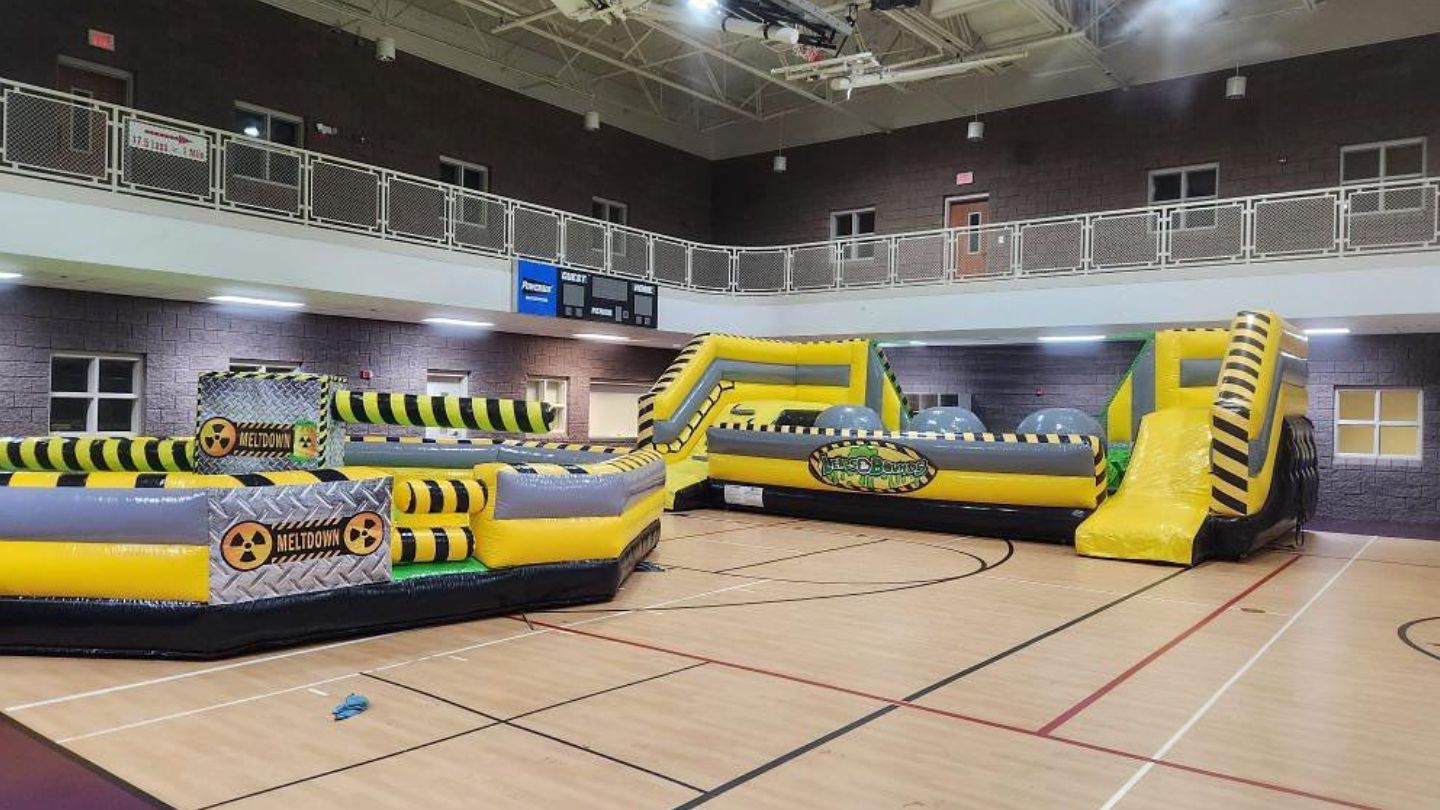Want to know how to set up a bounce house? This guide will take you through each step, from picking the perfect spot to ensuring you set up your bounce house properly, safely inflated, and secured. You’ll find straightforward, easy-to-follow instructions to help you set up your bounce house smoothly and safely.
Key Takeaways
- Choose a flat, debris-free location for the bounce house, considering safety and weather conditions before setup.
- Inflate and anchor the bounce house securely using ground stakes for grass or sandbags for hard surfaces, ensuring safety during use.
- Supervise children closely while using the bounce house, establish safety rules, and perform a thorough inspection before play begins.
Choosing the Perfect Location
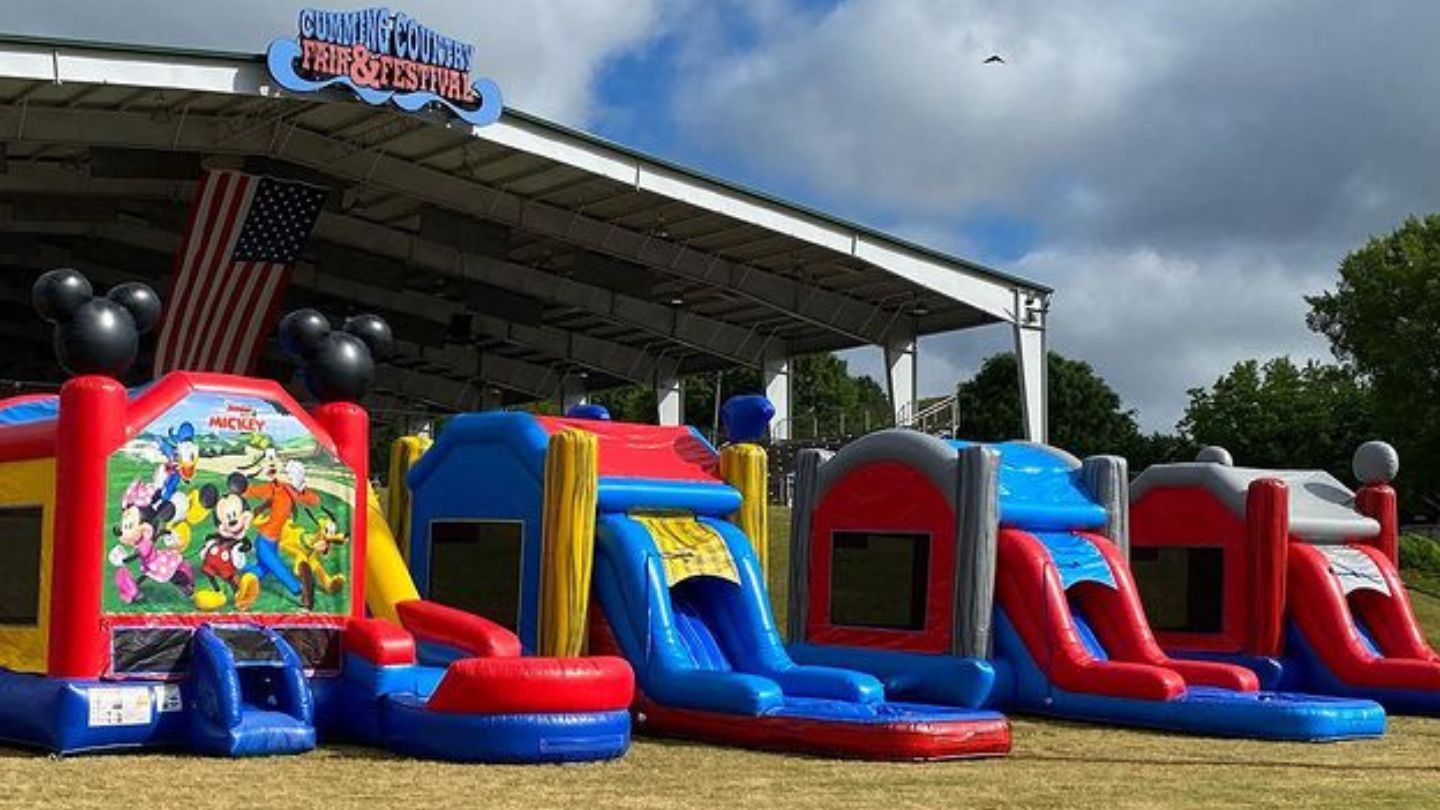
It’s essential to choose an appropriate location for your bounce house, prioritizing safety and stability over appearance. Avoid placing the bounce house near power lines, as this poses a potential safety hazard. Additionally, ensure the area is free from steep inclines to maintain the safety of children playing in the inflatable bouncer. Go for a level space that is clear of debris, pointed items, and animal droppings to safeguard the inflatable structure as well as those using it. Confirm there is sufficient clearance surrounding the bounce house so that no obstructions come into play after installation.
Consideration of surface type and prevailing weather conditions are paramount when addressing the safe use and pleasure derived from a bounce house. These topics will be examined in greater depth subsequently.
Checking the Weather
It’s crucial to consider the weather conditions before installing a bounce house. To prevent any interruptions due to inclement weather, always consult the local weather predictions beforehand. Harsh environments such as heavy rain or strong winds can pose serious dangers not just to the integrity of the bounce house but also to those enjoying it.
Should there be high winds, they might cause the bounce house to become airborne and result in possible mishaps. Keep an eye on meteorological updates continuously, and don’t hesitate to postpone or call off the event if poor weather appears imminent. Ensuring safety should be paramount at all times.
Grass vs. Hard Surface
When choosing a location for your bounce house, it’s crucial to consider whether you’ll place it on grass or a hard surface. Grass is typically favored because its softness provides cushioning, and the ability to secure the structure using ground stakes makes installation easier. If you choose to set up the bounce house on a driveway or another hard surface, take extra measures for safety.
Make sure that when placing the bounce house on such surfaces, they are level to avoid any potential harm to both users and equipment. Always position a tarp underneath it in order to shield against scuffs and wear. On these firmer grounds, sandbags can replace stakes for anchoring purposes. Regardless of whether you’re installing over grass or concrete, employing a tarp not only enhances stability but also offers additional protection underfoot.
Preparing the Bounce House
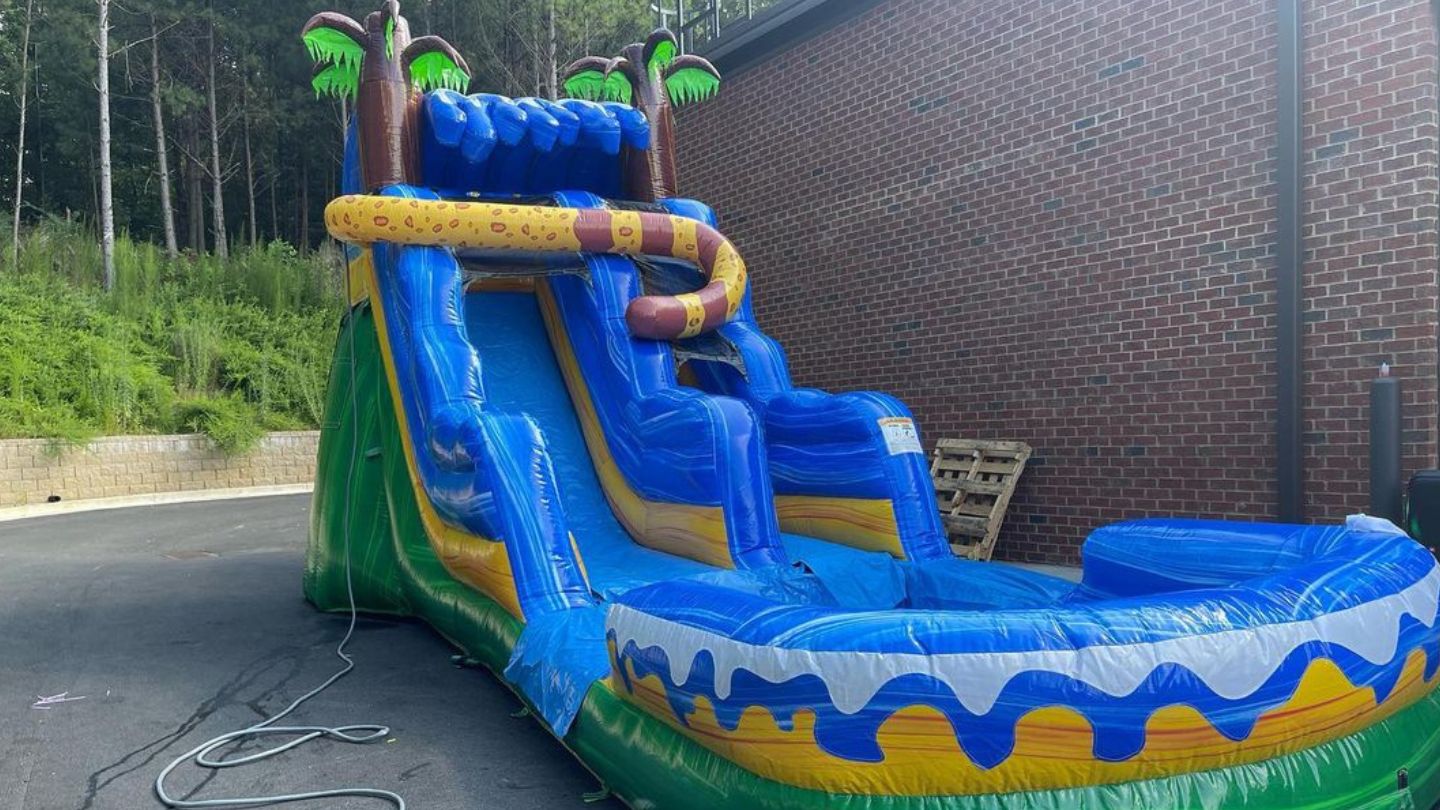
Select an appropriate location and ensure it is free from any objects that might harm the bounce house. Placing a tarp below can aid in maintaining its cleanliness and safeguarding it. Setting up most bounce houses is a quick process, often taking under 20 minutes, which means enjoyment awaits just moments away.
Before inflating the bounce house, make sure to close all the outlets to prevent air from escaping. Following this, proceed by unfurling the bounce house and attaching the blower for inflation purposes. We will delve into these procedures with more specificity.
Unfolding the Bounce House
Start by spreading out the bounce house on a tarp, making sure it is fully extended without any kinks or folds. Examine every seam carefully to make sure that they are whole and firmly sealed to avoid loss of air. Consistent cleansing, particularly after extensive use, is crucial for preserving both the structural integrity and cleanliness of the bounce house.
Before putting away the bounce house, confirm that it’s entirely moisture-free to ward off mold and mildew growth. These elements can deteriorate the fabric and present health dangers if not addressed. Attentive handling during this phase guarantees an effortless and secure setup when you next use the house.
Connecting the Blower
Begin by spreading out the bounce house, then attach the blower tube, ensuring that its outlet aligns perfectly with the air inlet of the bounce structure. It’s imperative to fasten it securely to create an airtight connection and avoid any loss of air while inflating.
It is vital to ensure there’s no air escape between the blower and where it enters into the bounce house. Secure this juncture with either Velcro or a zipper closure. Doing so guarantees swift and effective inflation.
Inflating the Bounce House
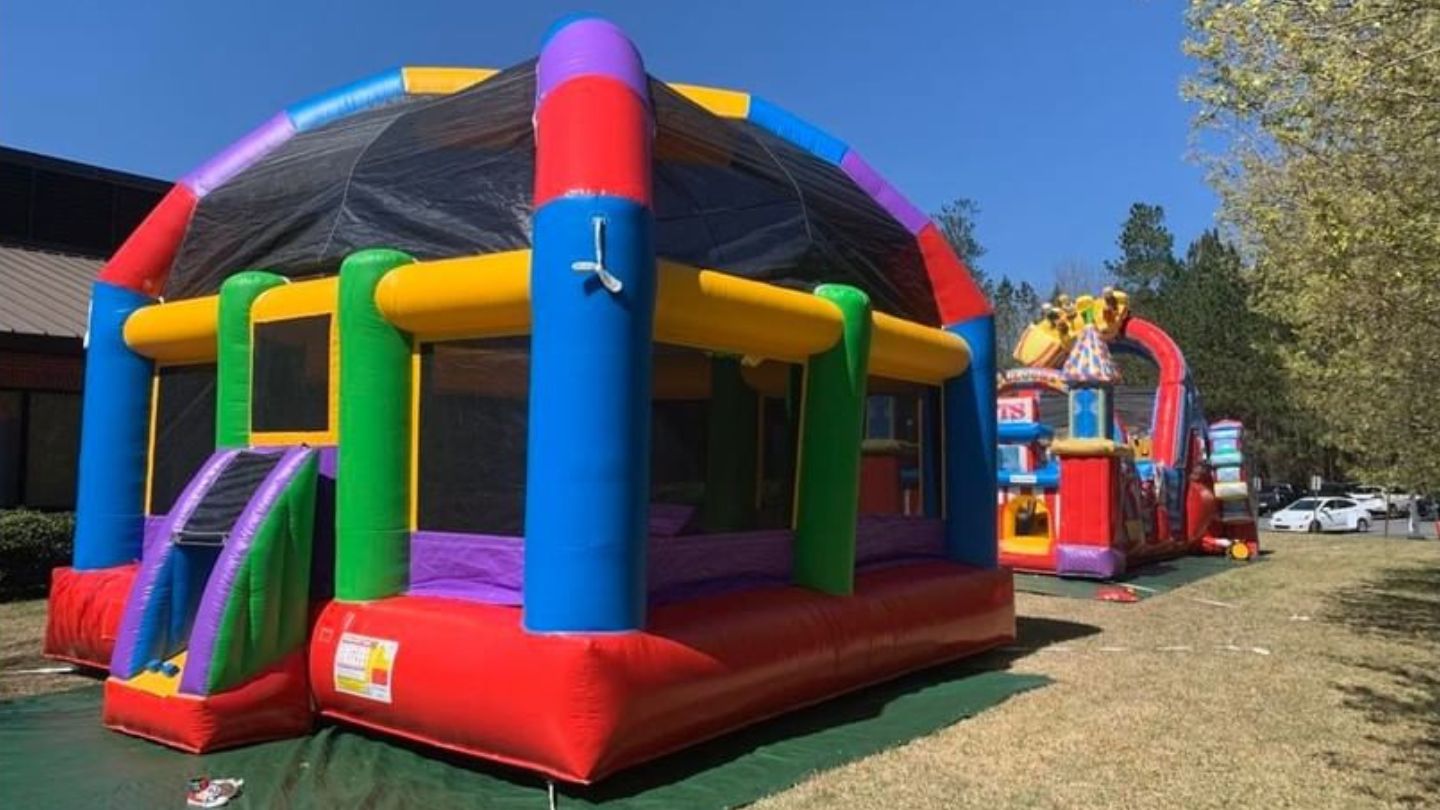
Begin the inflation of the bounce house by confirming that the blower is firmly attached and operational. It is crucial to know how to blow up a bounce house using the appropriate blower to ensure safety and efficiency. Establish a reliable power source for this process, and keep an eye out for any complications as it inflates.
Firstly, we will establish a stable power supply necessary for inflation. Following that, we will guide you step-by-step through how to inflate the bounce house efficiently.
Power Source Setup
To ensure that the bounce house is adequately inflated and operational, it is imperative to have a consistent power source for the blower. It is crucial that all the outlets are within reach of the blower to maintain safe functioning. Should the distance from an available power source be considerable, utilizing an extension cord becomes necessary. In situations where access to conventional electrical outlets isn’t possible, employing a generator will suffice.
Properly arranging this will guarantee that the bounce house stays completely inflated while in use, ensuring uninterrupted enjoyment and safety for those bouncing within it.
Inflation Process
Ensure the power source is prepared, and proceed to inflate the bounce house by securely sealing all of its air outlets and fastening the connection firmly. This will hinder any loss of air. The time it takes for inflation can vary depending on both the size of your bounce house and the strength of your blower. Typically, the bounce house takes about 10 to 35 minutes to fully inflate, depending on these factors. Hence, remaining patient during this process is essential.
It’s important to vigilantly observe the bounce house while it inflates in order to maintain an even distribution throughout and inspect for any possible leaks. Doing so helps ensure that everyone who uses it has a safe and pleasurable experience.
Anchoring the Bounce House
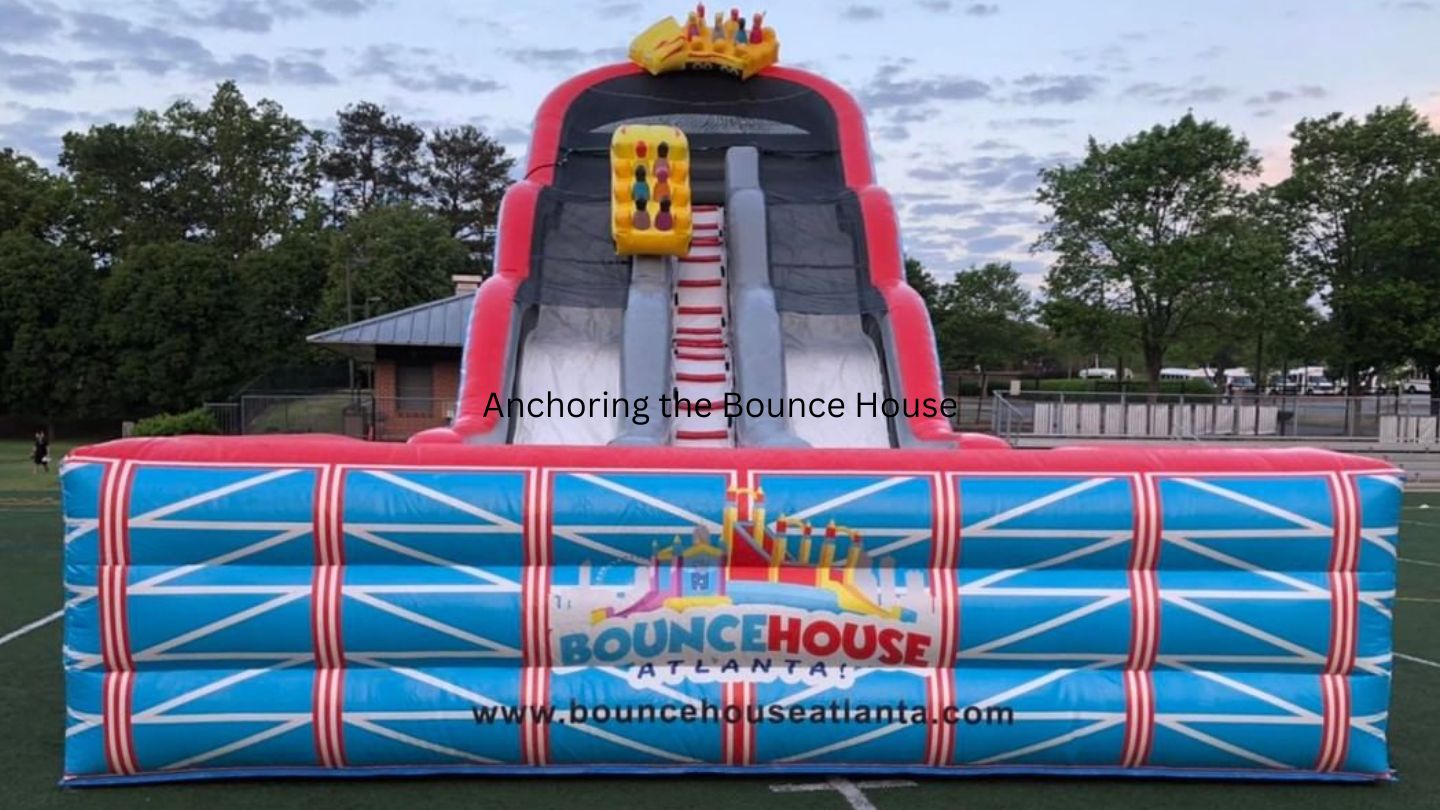
Once the bounce house is inflated, it’s imperative to fasten it securely to the ground to avert mishaps and maintain an environment conducive to safe play. Proper setup of inflatable bouncers is crucial, including selecting the right location, considering weather conditions, and ensuring proper anchoring. Depending on whether you’re setting up on solid ground or another type of surface, utilize either sandbags or stakes as anchors.
Ensuring that the bounce house is anchored correctly cannot be overstated in terms of importance. In our discussion, we will explore optimal anchoring techniques tailored for various types of surfaces while emphasizing the necessity to thoroughly verify all safety measures.
Ground Stakes and Sandbags
When installing a bounce house on grass, insert the ground stakes at a 45-degree angle away from the inflatable and push them halfway into the earth to firmly anchor it. If you are setting up on harder surfaces such as concrete or asphalt where stakes won’t work, choose sandbags instead.
It is advisable to utilize sandbags in conditions with strong winds to maintain the stability of the bounce house. No matter which method of securing you choose, it’s crucial that the inflatable is tightly anchored down so that there is no shift while it’s being used.
Double Check Safety
Before letting children have fun in the bounce house, it’s crucial to double-check each anchor point for robustness and stability. Carry out a detailed review of all anchors to confirm that there are no apparent dangers or components that may compromise stability.
Ensure the setup is stable and secure before giving kids the green light to begin their bouncing adventure. This essential last verification guarantees a safe and enjoyable environment for all participants.
Ensuring Safety During Use
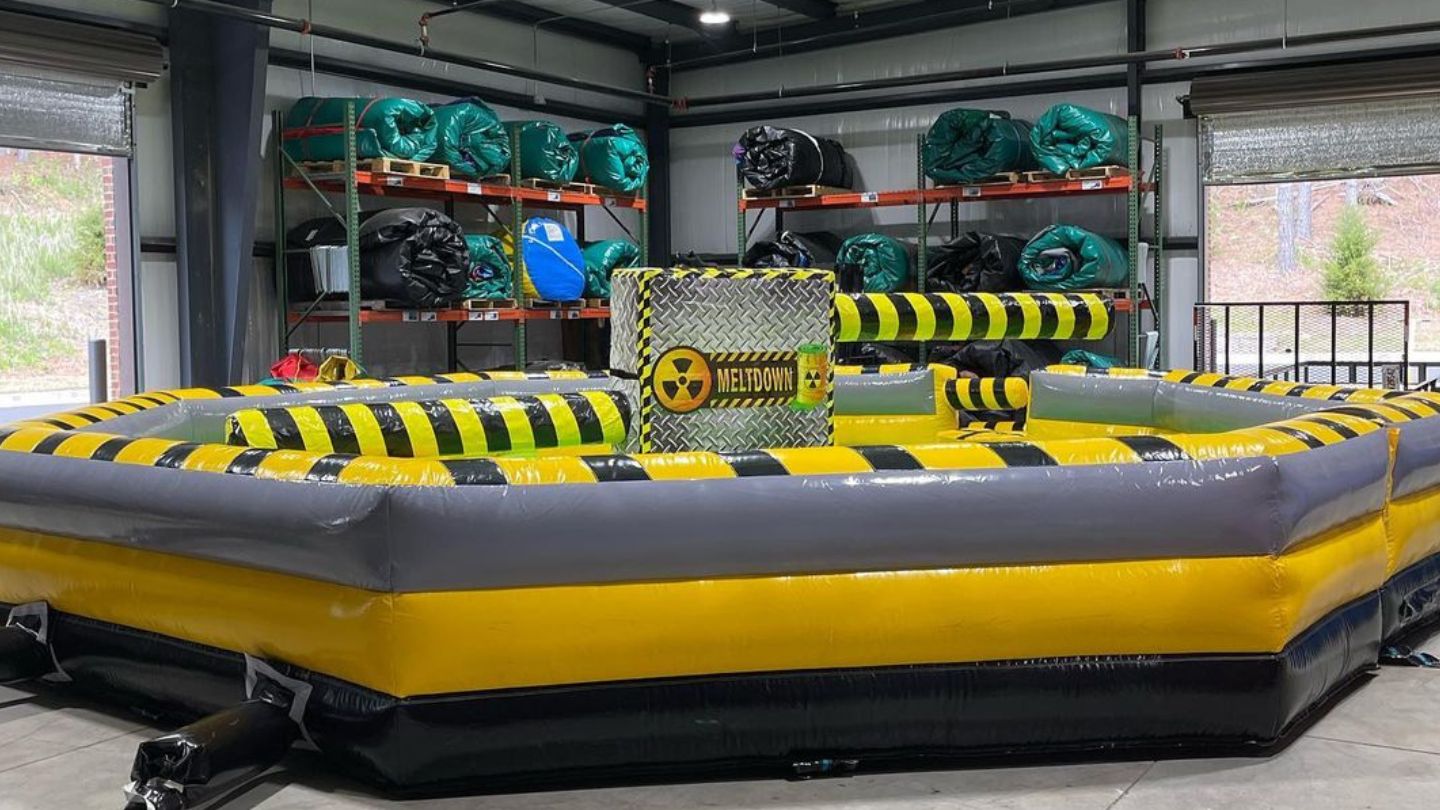
Once the bounce house is erected indoors, prioritizing safety throughout its use becomes crucial. Constant vigilance by an adult can markedly reduce the risk of injuries occurring. It is important to follow safety instructions for a bouncy house, including proper anchoring, checking the weather, and using blowers for inflation. Implementing explicit rules for play, like prohibiting aggressive playing or scaling the walls, helps preserve a secure setting and facilitates proper use of the bounce house.
The significance of vigilant adult supervision will be discussed alongside key safety instructions designed to safeguard all participants enjoying the bounce house.
Adult Supervision
It is imperative for adults to monitor the bounce house vigilantly at all times, especially when children from various age groups are interacting within it. Those in charge of supervising should remain alert and undistracted by things such as mobile phones or side discussions.
Ensuring that a qualified adult is always overseeing the activity inside the bounce house enhances safety measures and facilitates prompt action should any problem arise. This vigilant supervision considerably lowers the possibility of mishaps occurring.
Safety Instructions
It is essential to follow safety instructions meticulously to ensure a safe atmosphere. Observing the established limits on the number of occupants is crucial for avoiding excess capacity and potential mishaps. Regular inspections for any punctures and confirming that all seams are tight will preserve the structural soundness of the bounce house.
Creating comprehensive safety protocols bolsters both fun and protection for all participants in the bounce house activities. This encompasses preparing an immediate response strategy for instances where there might be an unplanned deflation of the bounce house.
Taking Down the Bounce House
After the event concludes, proceed with caution as you dismantle the bounce house. Bounce house rentals are crucial for event setups, and understanding the process of deflation is essential for maintaining the equipment. Begin by shutting off the blower to initiate safe deflation of the unit. The correct method to deflate includes unzipping any deflation ports and then systematically folding and rolling up the bounce house in such a way that it pushes out all remaining air effectively.
Next, we’ll delve into how one should carry out both cleaning and storage procedures following inflation, ensuring that we preserve the integrity and quality of the bounce house for future use.
Deflation Process
To ensure proper inflation of the bounce house, first switch off the blower and unzip the assigned zippers. Carefully guide any residual air towards these openings, taking care not to harm the fabric in the process.
It’s important to methodically fold and roll up the bounce house to effectively remove all remaining air, guaranteeing that it is fully deflated before you proceed with its cleaning or storage. Performing this step meticulously is essential for preserving both its quality and durability.
Cleaning and Storage
To maintain the safety and longevity of the bounce house, it’s important to engage in proper cleaning by using a gentle cleansing solution along with soft brushes. This ensures that you avoid harming the fabric. Once deflated, shield the bounce house from dust and critters by securing it within a robust storage bag.
When choosing a location for storing your deflated bounce house, opt for an area that is both dry and raised above ground level to protect against harm due to dampness or heavy objects pressing against it. Adhering to these steps guarantees that your bounce house remains in top condition, safeguarded, and primed for future enjoyment.
Bounce House Atlanta
At Bounce House Atlanta, we specialize in providing top-notch bounce house rentals and inflatable attractions to make your events unforgettable. Our extensive selection of bounce houses, water slides, and interactive games ensures that we have something for everyone. Whether it’s a birthday party, corporate event, or community gathering, our professional team is dedicated to delivering safe, clean, and fun-filled entertainment. Trust Bounce House Atlanta to bring joy and excitement to your next event!
Summary
Choosing an appropriate location and executing a proper setup are essential elements in creating a delightful and secure bounce house experience. By meticulously following the detailed instructions for installation, use, and disassembly of the Atlanta bounce house rental from Bounce House Atlanta, you will ensure that participants have an enjoyable time while prioritizing their safety.
The cornerstone of a triumphant event featuring a fun-filled bounce house lies in thorough preparation, continuous monitoring, and strict compliance with established safety measures. Employ these strategies to guarantee your forthcoming gathering is filled with joyous, bouncing triumphs! For more details on our services, visit Bounce House Atlanta.
Frequently Asked Questions
What is the best surface for setting up a bounce house?
Grass is the best surface for setting up a bounce house because it provides softness and allows for secure anchoring. Bounce house rental businesses thrive on providing safe and enjoyable experiences, making the choice of surface crucial for customer satisfaction and repeat rentals.
If using a hard surface, ensure you take extra precautions with tarps and sandbags for stability.
How can I ensure the bounce house is safe during use?
To ensure the bounce house is safe during use, maintain continuous adult supervision, adhere to maximum occupancy limits, and regularly check for leaks and secure seams.
This proactive approach will help keep everyone safe while enjoying the bounce house.
What should I do if the weather turns bad during the event?
To effectively clean and store your bounce house, use a mild cleaning solution with soft brushes, making sure it is completely dry before placing it in a durable bag.
Store it in a dry, elevated area to prevent damage.
How do I clean and store the bounce house after use?
To effectively clean and store your bounce house, use a mild cleaning solution with soft brushes, making sure it is completely dry before placing it in a durable bag.
Store it in a dry, elevated area to prevent damage.
Can I set up a bounce house indoors?
Yes, you can set up a bounce house indoors, provided there is adequate space and a suitable power source. Ensure the area is clear of obstacles and adheres to safety guidelines just like an outdoor setup.

